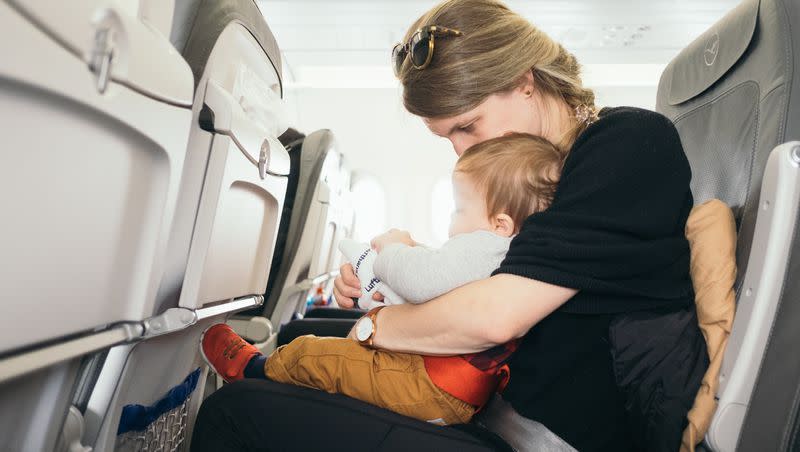It’s not safe to hold your baby on a plane. Here’s what to do instead

A recent airplane incident is raising questions about aviation safety, and experts are encouraging parents to secure their infants and small children in proper seats.
On Jan. 5, an Alaska Airlines flight departing Portland had to make a quick return after a panel of the Boeing 737 came off shortly after departure, leaving a large hole in the wall.
The New York Times reports no passengers were harmed, although several phones and other items were sucked out of the plane after the sudden hole caused the cabin to depressurize.
Since the event, aerospace safety experts from the National Transportation Safety Board have been reminding the public that it’s important to keep children safely strapped in at all times while in an airplane.
Had anyone close to the Boeing’s hole been holding an infant, the strong winds likely would have ripped them from their arms, according to Kwasi Adjekum, assistant professor at the University of North Dakota’s Department of Aviation.
“The practice of holding kids on your lap, especially for takeoff and other vulnerable phases of flight — it’s highly frowned upon and discouraged,” Adjekum told The Washington Post.
Related
What do safety experts say about bringing babies on planes?
Even if a hole doesn’t open on the side of an airplane, unsecured infants and small children can be injured in an accident or due to turbulence. The Federal Aviation Administration reports that turbulence is the greatest cause of pediatric injuries on airplanes and says it is impossible to properly secure a child by holding one in your lap.
Most airlines do not require children under the age of 2 to have a ticket as long as they sit on their parent’s lap. The FAA has no official requirements for infant security, although its website does have several recommendations for flying with children. The FAA reports that the best course of action is to secure children in approved child restraint systems, or CRS, such as car seats or booster seats.
The American Academy of Pediatrics recommends that infants weighing less than 20 pounds travel in a rear-facing car seat, while children who weigh between 20 and 40 pounds should buckled in a car seat. Toddlers between 22 and 44 pounds can also be buckled into an FAA-approved airplane safety harness called the Child Aviation Restraint System, or CARES.
Safety tips for babies and toddlers on airplanes
To recap, here are the main recommendations from safety professionals if you want to keep your children safe on an airplane.
1. Make sure your child has their own seat
It’s tempting to forgo the cost of another plane ticket and simply hold your child on your lap, but if you’re able, experts agree that it is much safer to place the child in a child restraint system in their own seat.
Be sure to choose a seat directly next to the child’s parent or guardian and check your airline’s infant travel policy when selecting seats. According to Delta, child safety seats are best placed in the window seats and should not be in aisle seats or emergency exit rows.
2. Choose a CRS that is approved for use on airplanes
Check the label or safety information of your chosen car seat or other child restraint system and make sure it has been approved not only for cars but also for airplanes.
Additionally, you’ll want to measure it beforehand to ensure it will fit on the plane seats — as long as the child restraint system is no wider than 16 inches, it should fit.
3. Try to do a diaper change before you board the flight
Since it’s best to keep children safely secured in their seats, you want to do everything possible to minimize the chance that they’ll have to get out. If your baby has a clean diaper and has recently eaten, they’re more likely to nap on the flight.
However, if your baby needs a diaper change midflight or is screaming to be held, you may have to take them out. If that happens, be sure to hold them securely, and if changing their diaper (many airplane restrooms have changing tables), keep at least one hand on them at all times.
You can also invest in a baby carrier or wrap to keep your child secured to your body while in the air.

